Tha Phae Gate: Your Guide to Chiang Mai's Historical Landmark
Tha Phae Gate is one of Chiang Mai’s most iconic historical landmarks, seamlessly connecting the city’s past with its vibrant present. It’s one of those places where you can almost feel the centuries-old stories in the air. As one of the best-preserved sections of the old city wall, it’s a symbol of Chiang Mai’s rich heritage. More than just a tourist attraction, Tha Phae Gate is a place where history, culture, and community converge.
Chiang Mai, founded in 1296 by King Mengrai, was designed to be the heart of the Lanna Kingdom. The city’s layout, a square surrounded by sturdy walls and a protective moat, was carefully planned to keep invaders at bay. Tha Phae Gate, initially known as Chiang Ruak Gate, was one of the main entry points into this fortified city. It served as a gateway to the eastern trade routes, welcoming merchants, pilgrims, and travelers who played a key role in shaping Chiang Mai’s identity. Standing here today, it’s easy to picture the scene centuries ago—traders bustling through the gate, carts full of goods, and the hum of different languages filling the air.
Nowadays, Tha Phae Gate is more than a piece of history; it’s a lively meeting point where locals and visitors alike come to experience the heart of Chiang Mai. It’s often the perfect starting spot for anyone exploring the old town, with its winding streets, ancient temples, and vibrant markets. Right around the gate, you’ll find plenty of food vendors selling classic northern Thai dishes, cozy cafés that invite you to sit and watch the world go by, and little boutiques offering everything from handmade crafts to modern designs. On weekends, the area truly comes to life, transforming into a hub of activity with cultural performances, events, and the famous Sunday Walking Street Market. The mix of street food, handmade crafts, and lively entertainment gives a true taste of Chiang Mai’s spirit.
Visiting Tha Phae Gate isn’t just about checking off a historical site—it’s about stepping into the living heart of Chiang Mai. The gate stands as a reminder of the city’s ability to adapt and thrive, from its days as a fortified stronghold to its present role as a cultural hotspot. For anyone exploring Chiang Mai, Tha Phae Gate isn’t just a landmark—it’s a doorway to understanding what makes this city so special: its history, its culture, and the warmth of its community.
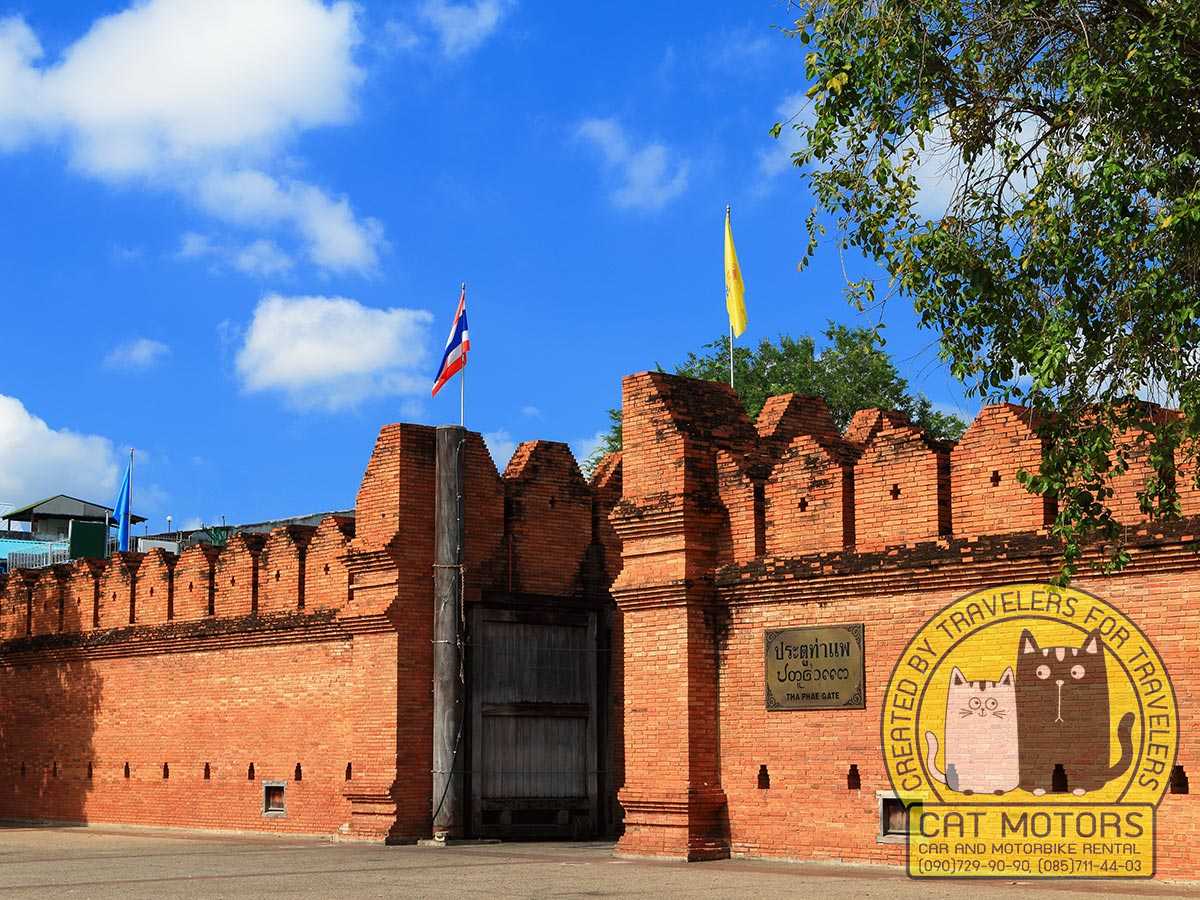
Today, the gate and nearby square are a hive of activity, home to markets, shows, and interesting sites. Let’s look at what you can expect when visiting this ancient landmark.
History And Culture
Tha Phae Gate was believed to be constructed in the early 13th century, shortly after the city’s foundation. Its original purpose was to serve as a defensive structure against Mongol and Burmese, allowing controlled access to the city and protecting it from potential invasions. The gate is located on the eastern side of the old city’s walls and is one of the five original gates to the city.
In the past, this ancient gate played a crucial role in the city’s transportation and trade. Translated, Tha Phae means “raft landing.” It was a significant hub for merchants, traders, and travelers entering or leaving Chiang Mai. The gate also served as a checkpoint where goods were inspected and taxed.
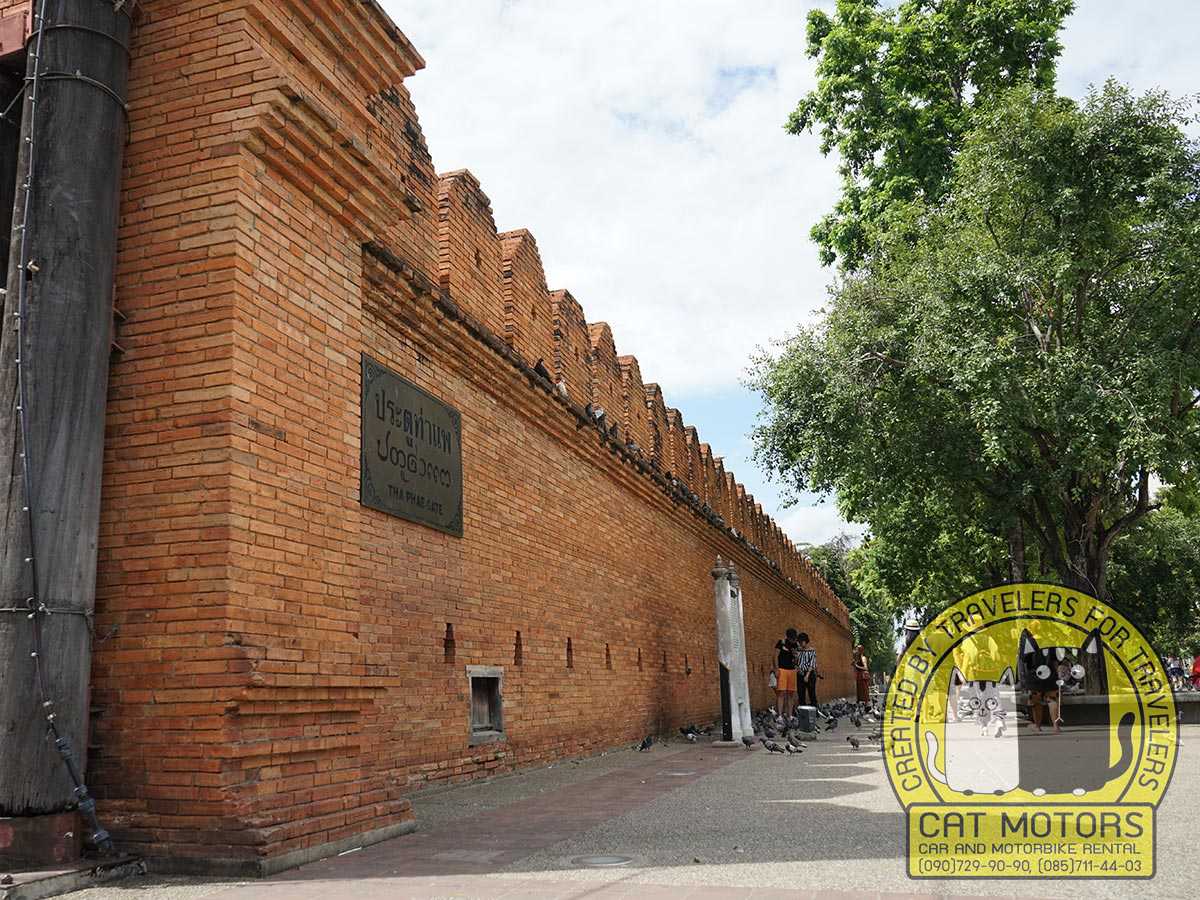
Over time, as the city expanded beyond its walls, the gate lost its military and defensive importance and deteriorated with time and material theft. The outer wall was removed, leaving only the inner wall. However, it continued to hold cultural and symbolic significance for the local population, and the local community funded its reconstruction.
Today, Tha Phae Gate stands as an iconic symbol of Chiang Mai’s rich history and cultural heritage. It has become a popular tourist attraction and is a gathering place for locals and visitors. The area around the gate, called Tha Pae Square, is bustling with activity, featuring shops, cafes, and street vendors.
Additionally, this part of the old town is often the starting point for traditional festivals and processions in Chiang Mai. It is a favored spot for locals to gather during important events, such as New Year’s celebrations or Yi Peng. During this festival, floating lanterns are released into the sky.
Exploring Tha Phae Gate
The original wall and gate have undergone several renovations and modifications over the centuries. It was initially built using a combination of brick and laterite, a type of rock commonly found in the region. The gate features architectural elements influenced by the Lanna and Burmese styles, reflecting the historical and cultural exchange between the two kingdoms.
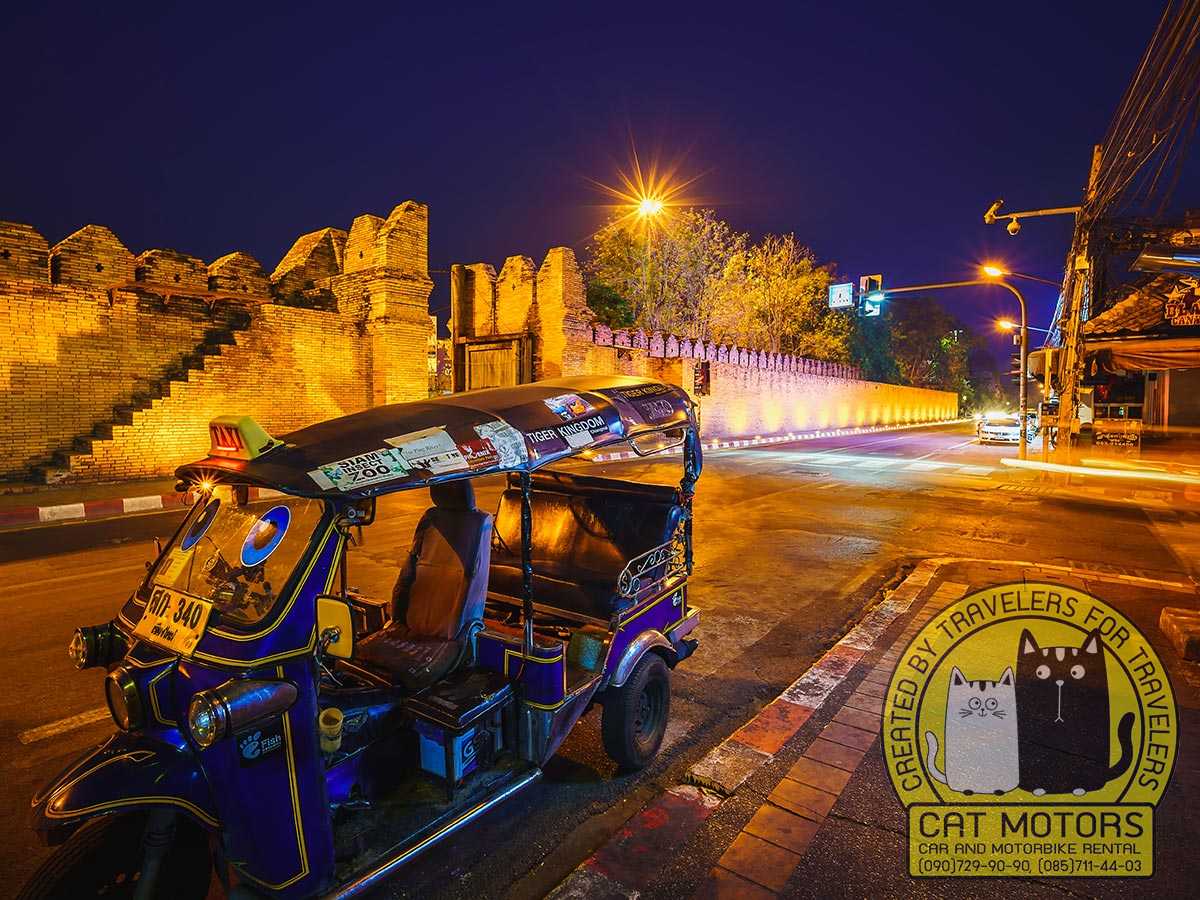
Some of the notable features and design elements of Tha Phae Gate include the following:
- The rectangular gate structure consists of three parts: the main gate, the battlements, and the fortress. Two tall walls on either side flanked the gate, creating a grand entrance.
- At each corner of the gate are two towering structures known as “prang.” These towers serve both decorative and functional purposes.
- Elaborate carvings can be found throughout Tha Phae Gate, depicting scenes from Buddhist mythology, religious symbols, and intricate floral patterns. These carvings showcase the artistic skills and attention to detail of the artisans involved in its construction.
- The balustrades on either side of the gate are adorned with intricately designed naga (serpent) sculptures. These mythical creatures are prominent in Southeast Asian folklore and are believed to bring protection and good luck.
- In front of the gate is a bridge that spans the moat, providing access to the gate itself. During festive occasions, the bridge is often lined with traditional red and gold lanterns.
- Since Tha Phae Gate was designed initially as a defensive structure, it incorporates defensive elements. These include battlements, small openings for archers, and strategic vantage points to guard against potential threats.
What To Expect In The Area
Walking around Tha Phae Gate, you will notice it is a busy commercial area with a mix of Eastern and Western influences. However, you will see temples, monuments, and other popular Chiang Mai attractions between the shops and hotels.
Of course, many activities are hosted at this central location. There is a permanent market on the go, given the spot’s popularity. The market extends into the nighttime, too, so you’ll always have something to peruse when you’re there.
The permanent market differs from other tourist markets in Chiang Mai in that the vendors create much of the handiwork onsite using traditional methods. For instance, weavers, carpenters, potters, and metalworkers create clothes and old-fashioned household items. While their prices aren’t cheap, their products are authentic and of a higher quality than those at other markets.
The Tha Phae Square is a hub for all sorts of events and is especially busy during festivals. For instance, during Yi Peng and Loy Krathong Festivals in November, the square marks the start of the lantern parades and ceremonies. It is heavily decorated with lanterns and colorful flowers, making it a sight to behold day and night.
The same is true for the Chiang Mai Flower Festival, which is held on the first weekend in February. The opening ceremony is held in the square, and a parade goes past it later in the festival. Around the square and gate, you will see and smell hundreds of thousands of flowers and ornamental plants.
Fun Activities
The gate is a great starting place to explore this part of Chiang Mai. When you have finished admiring its interesting architecture, there are plenty of other activities for you.
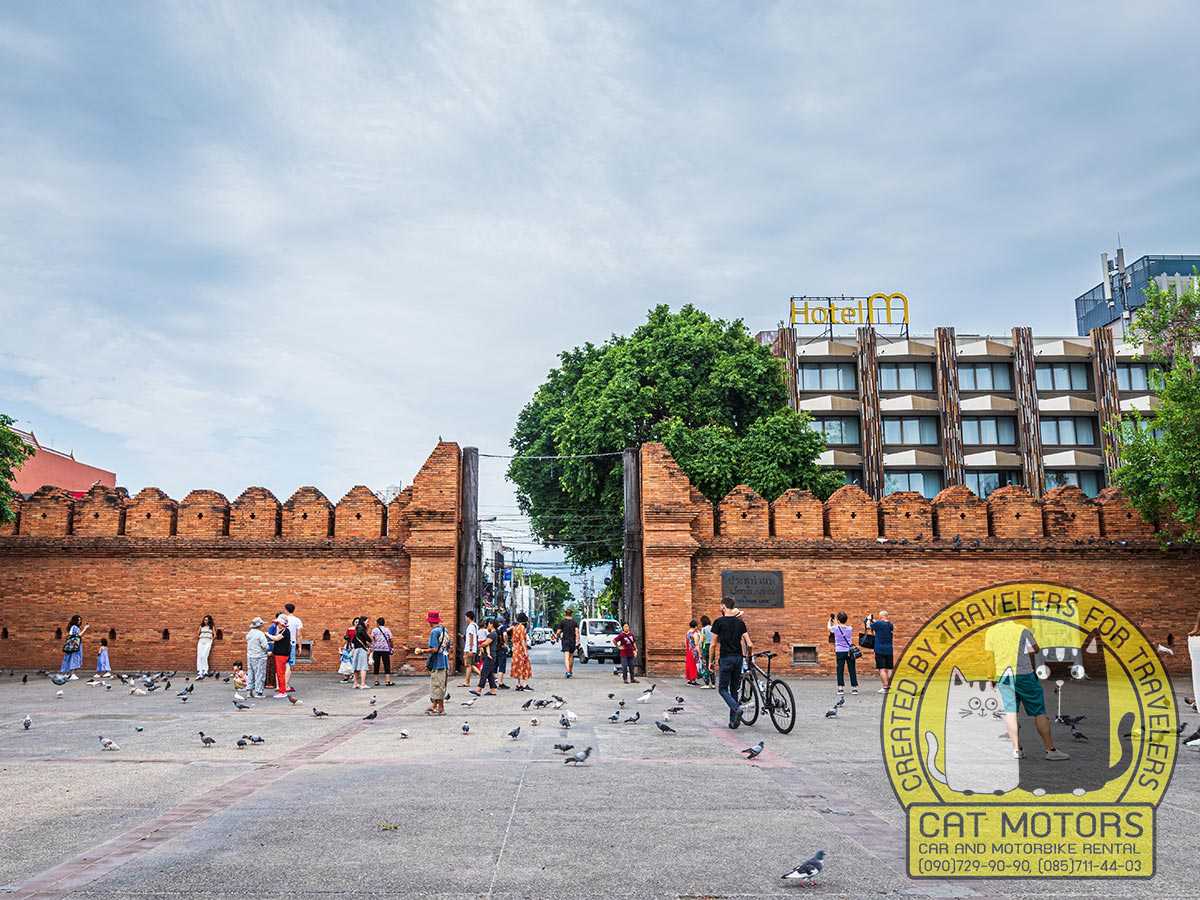
A popular activity here is to have your photo taken by the gate’s plaque as hundreds of pigeons fly around you. Many tourists and locals pay the entrepreneurial “pigeon spookers” to unsettle the pigeons for an action shot. While it can make a good photo, there are signs around requesting that people do not feed the pigeons as they become pests.
Let’s look at some other activities for you to consider when visiting Tha Phae Gate:
Walking And Biking Tours
Walking or riding a bicycle is the best way to explore this central part of Chiang Mai. If you want a guided tour, consider signing up for a bicycle tour that takes you to landmarks, temples, and markets in the area.
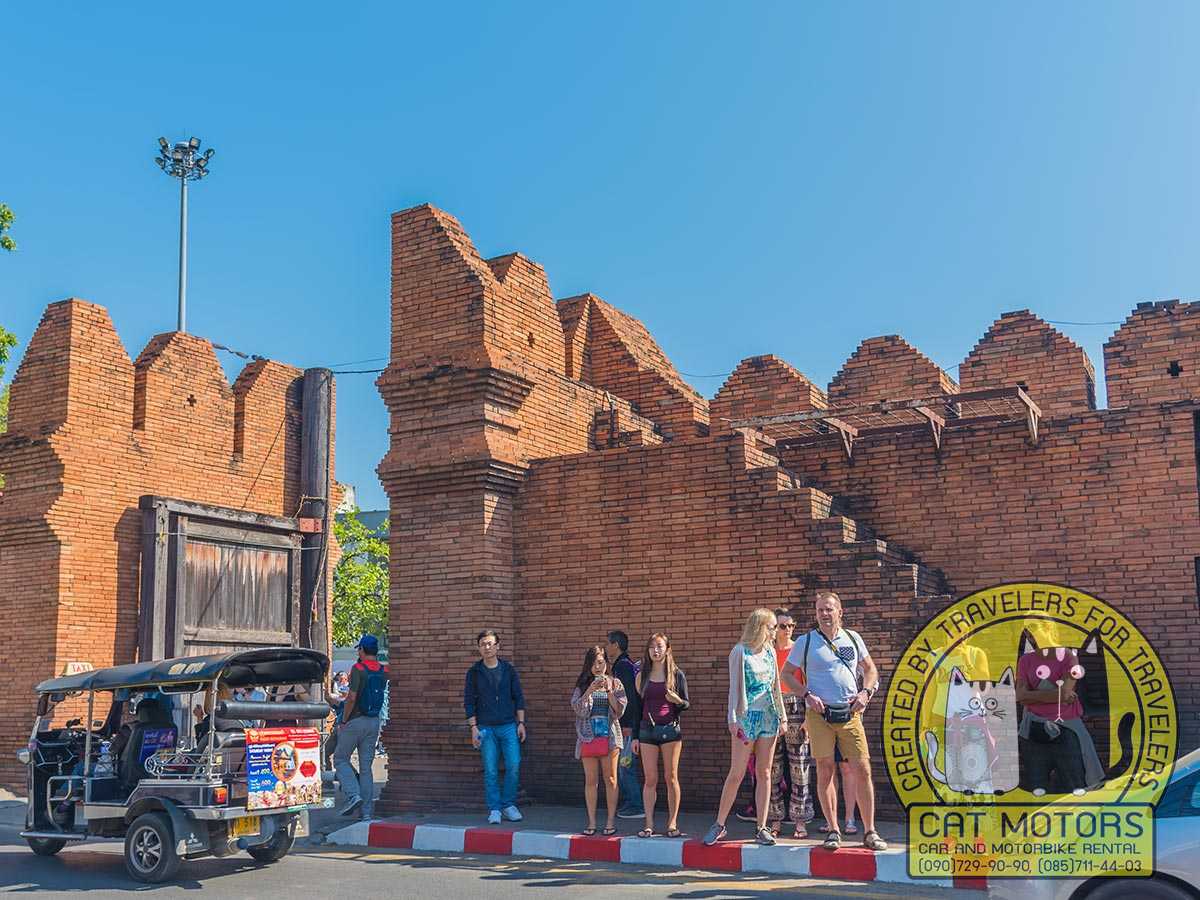
Alternatively, consider walking or riding this 7.6 km (4.7 mi) loop trail. It starts on the eastern side of Iron Bridge, crosses over Ping River, and goes to Tha Phae Gate and beyond. The best time to do this route is in the early morning, when you can greet the monks going about their chores and watch the city wake up and start the day.
Shopping At The Night Market
Every Sunday, a market starts at 4 pm and extends to midnight. It is commonly known as the Thapae Walking Street Market, extending 1.5 km (0.93 mi) down Rachadamnoen Road, which is closed for this weekly event.
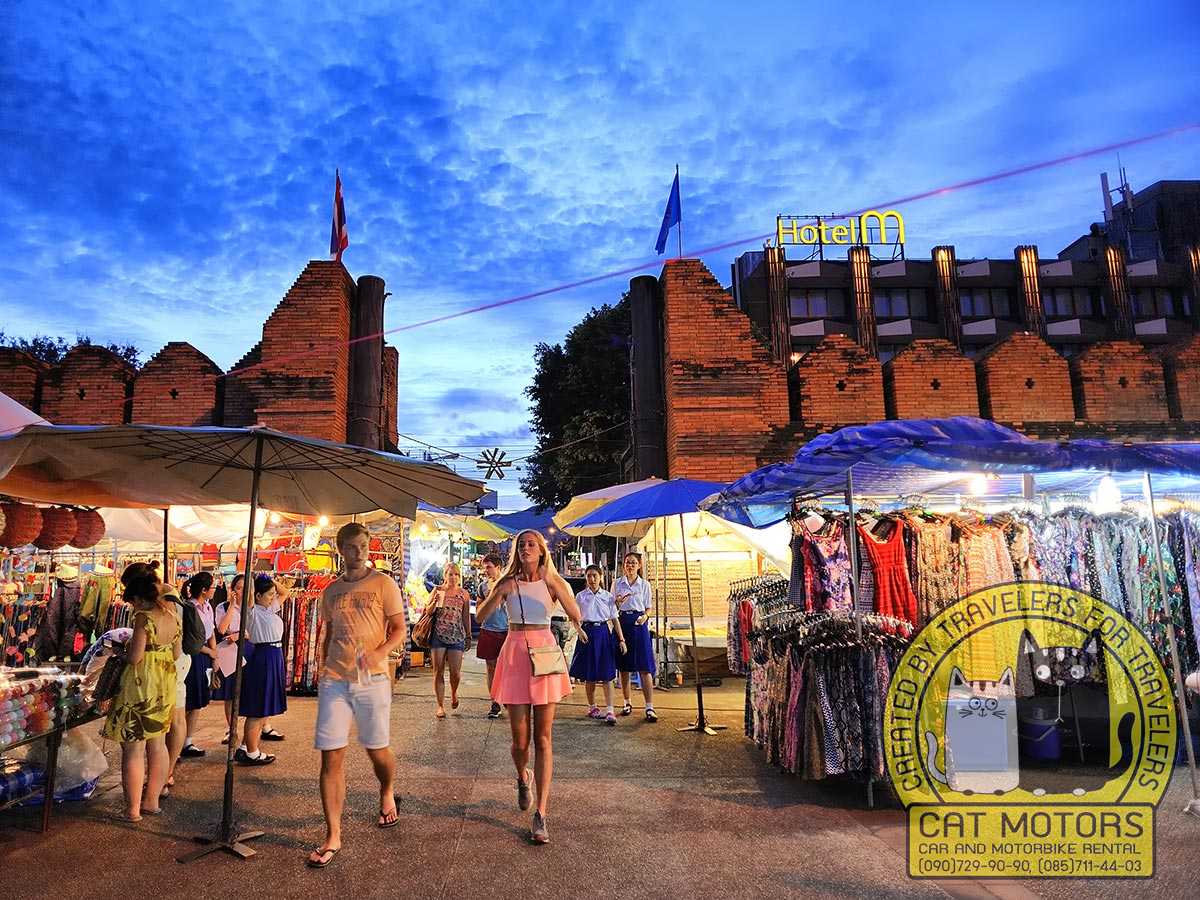
Walking Street has much to offer for locals and tourists alike. For instance, you can buy Hill tribe products, artworks, woven silk and fabrics, wood carvings, lamps, and clothes. Remember to haggle for a reasonable price, as the vendors consider this a fun habit, and negotiate happily with buyers.
And, when you’re done checking out the night bazaar, be sure to visit Asunarm Market and Kalare Night Bazaar. Both are offshoots of the night bazaar.
Enjoy The Shows
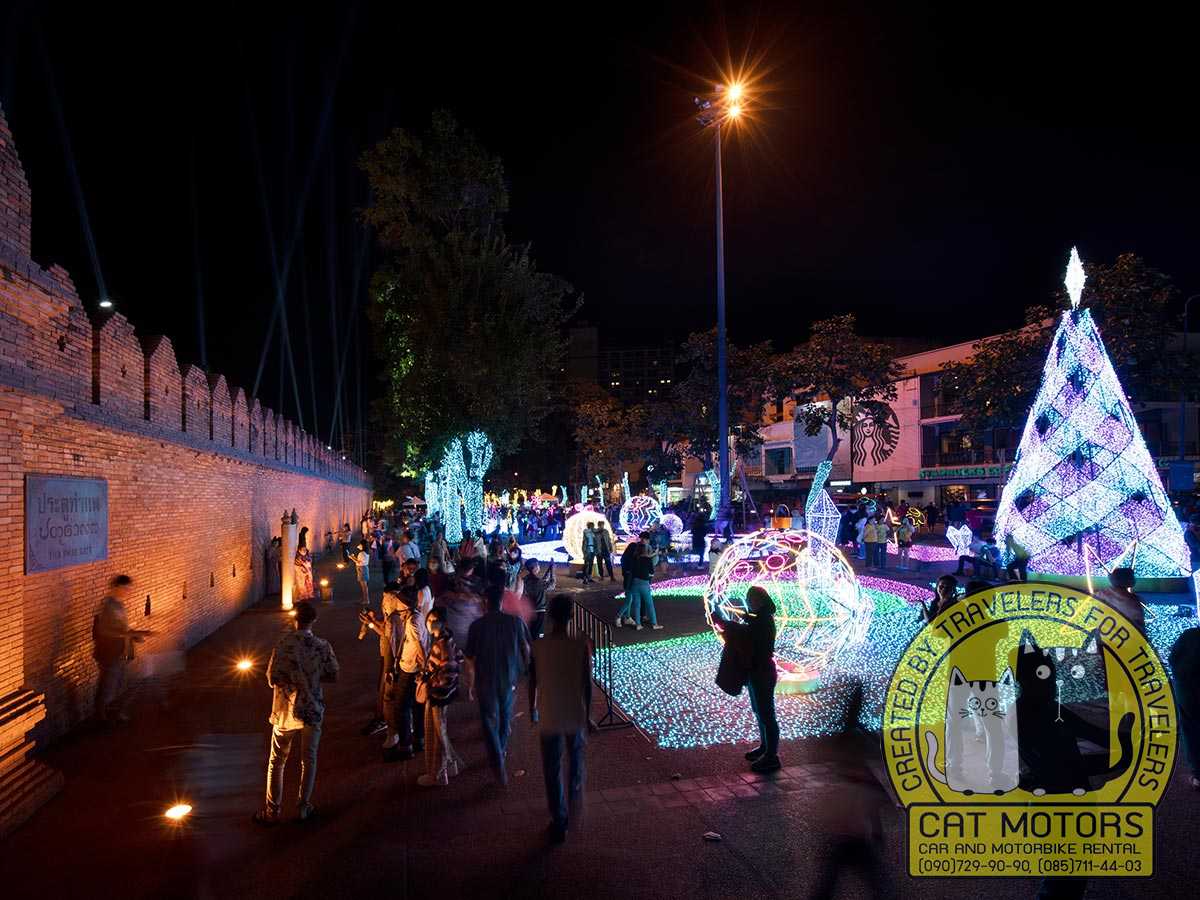
There are dance performances, live music, and beauty pageants during the night market and other events. The sois (or lanes) on either side of the road act as street performance areas for the various entertainers. Additionally, on Saturday nights, you can enjoy live music shows in the square.
Food And Drinks In The Area
In the plaza in front of the gate is a food court selling traditional dishes from Chiang Mai, e.g., Chiang Mai sausage and Khao Soi. The food prices at the market are reasonable and popular with locals and tourists.
Many other eateries sell local and Western food in the area, too. Some of these include popular fast-food chains like Burger King, MacDonalds, and Starbucks.
Tips For Visiting
Tha Phae Gate and Square are a wide space open to sunlight and soaring temperatures. The busiest time is mid-morning before the temperatures reach midday high. There are trees around the gate and square, but many people sit or lie beneath them to escape the sun.
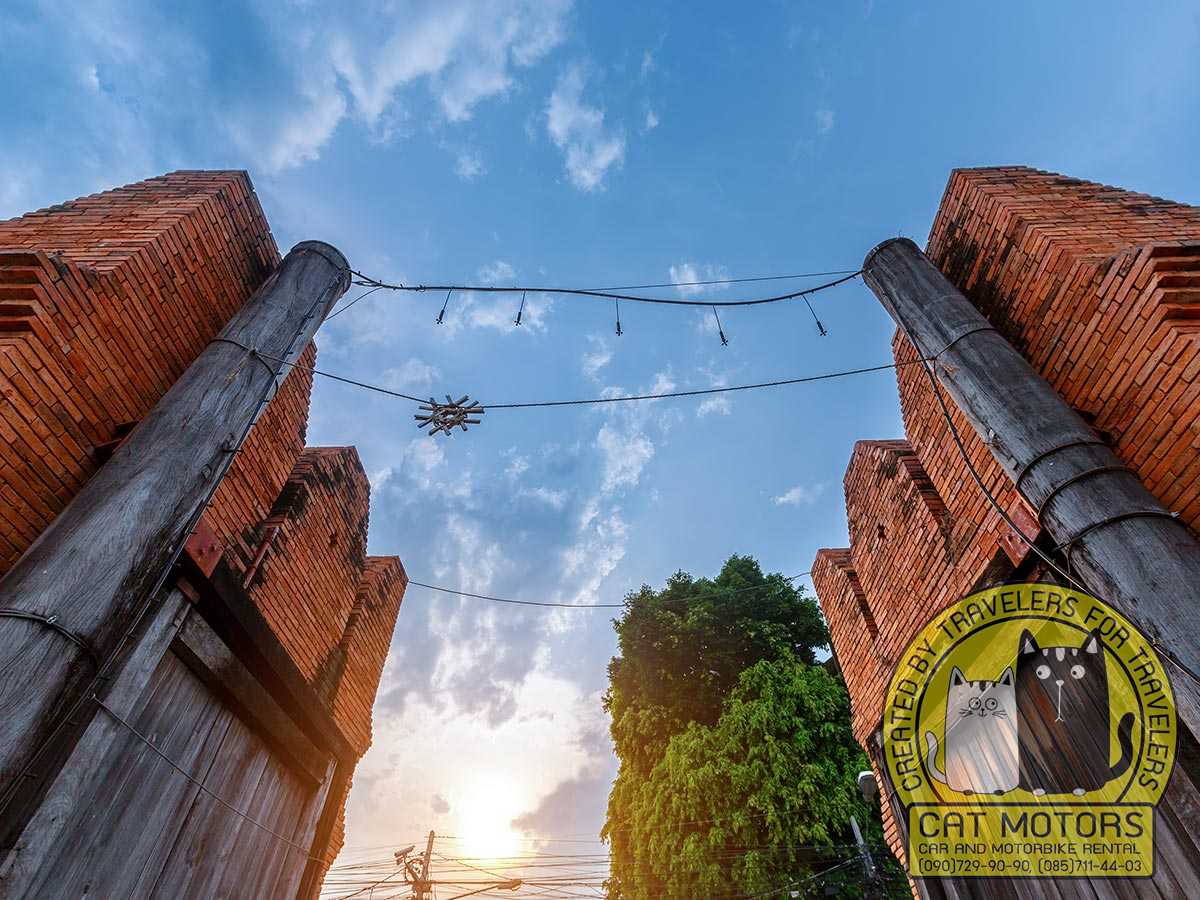
It is advisable to wear sunscreen, a hat, cool clothes, and shoes when you visit during the day. The ground gets incredibly hot to walk on with flimsy shoes, and heatstroke is a real risk if you’re not used to such temperatures. Additionally, make sure you keep hydrated; there are many shops (including two 7-11s) nearby for you to buy water or other refreshments.
The best time to visit the gate and square is during one of the Chiang Mai festivals or the Sunday night markets. Just be prepared for it to be very crowded. Also, when it is crowded, keep your valuables in a backpack or handbag that you can hold securely, and refrain from keeping things in your back pockets. As safe as Chiang Mai is, pickpockets are about, especially when it is busy.
Nearby Attractions And Places To Visit
When you’re at Tha Phae Gate, you’ll be close to dozens of other historical landmarks in the area, making it a convenient starting point. Additionally, there are many restaurants, cafés, and places to stay. Listed below are some of them:
Old City
As mentioned, the gate is one of the entrances to the old city. The ancient city of Chiang Mai is full of sights, including ruins, temples, and monuments. Wandering around the original city, you’ll be able to learn and appreciate its history of over 700 years.
Wat Lok Moli
Wat Lok Moli is a 14th-century temple housing a relic of Buddha. Also on site is the Great Pagoda, with twelve smaller pagodas resembling twelve northern Thailand temples. The twelve zodiac signs are represented alongside the pagoda with the view to allow believers to worship according to their own sign.
Wat Jed Yot
Wat Jed Yot is another ancient temple, completed in 1455. This holy place was the conference center for over a hundred monks in 1477. The temple is a serene place to visit, where you can watch young monks copying Buddha images onto the pagoda walls.
Bhubing Palace
Bhubing Palace is the Thai Royal Family’s winter residence overlooking Chiang Mai. While it is not ancient (built in the early 1960s), it is a beautiful place to visit.
Chiang Mai Gate
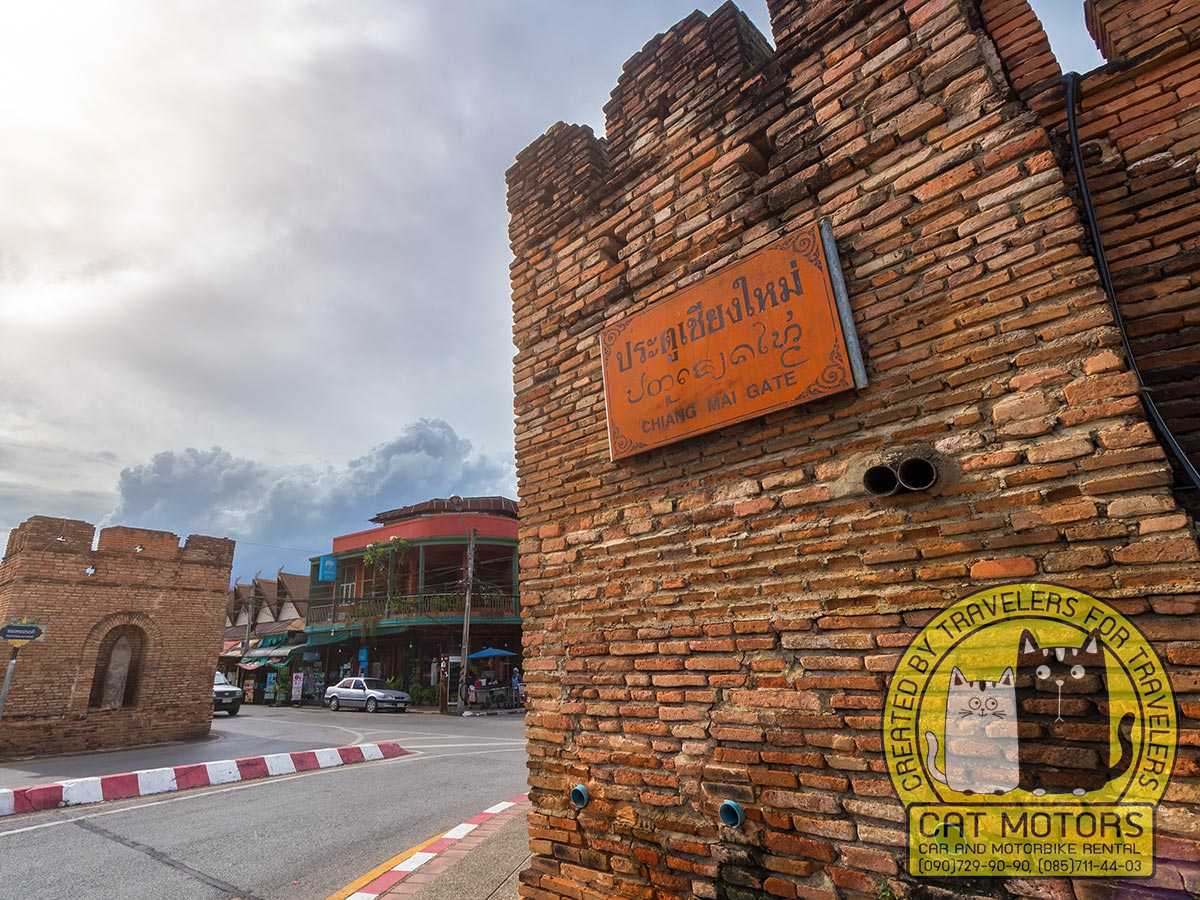
Chiang Mai Gate is the old city’s south gate, and it is still relatively intact, like Tha Phae Gate. A night market is held here every Saturday night, and the vibe is lively.
Wat Mahawan
Wat Mahawan is an ancient, Burmese-style temple combining Lanna and Burmese architecture. Wat Mahawan has distinctive pagodas, ornate halls, and triple-layered eaves, giving it a solemn look.
Suan Dok Gate
Suan Dok Gate is perhaps one of the quieter gates of ancient Chiang Mai. Its high red brick walls are quite well preserved, and there is an old brick pagoda nearby and a lot of greenery.
Chang Phuak Gate And Night Market
Chang Phuak Gate night market is much smaller than the Tha Phae night market. The market runs every night, and it’s an excellent place to get snacks like the popular Fengfeifei Pig’s Foot Rice.
Our Summary
If you’re visiting northern Thailand, make a point to visit the old Lanna capital steeped in history. Tha Phae Gate is one of its ancient gates, built over 700 years ago and restored as a symbolic landmark with fascinating architecture.
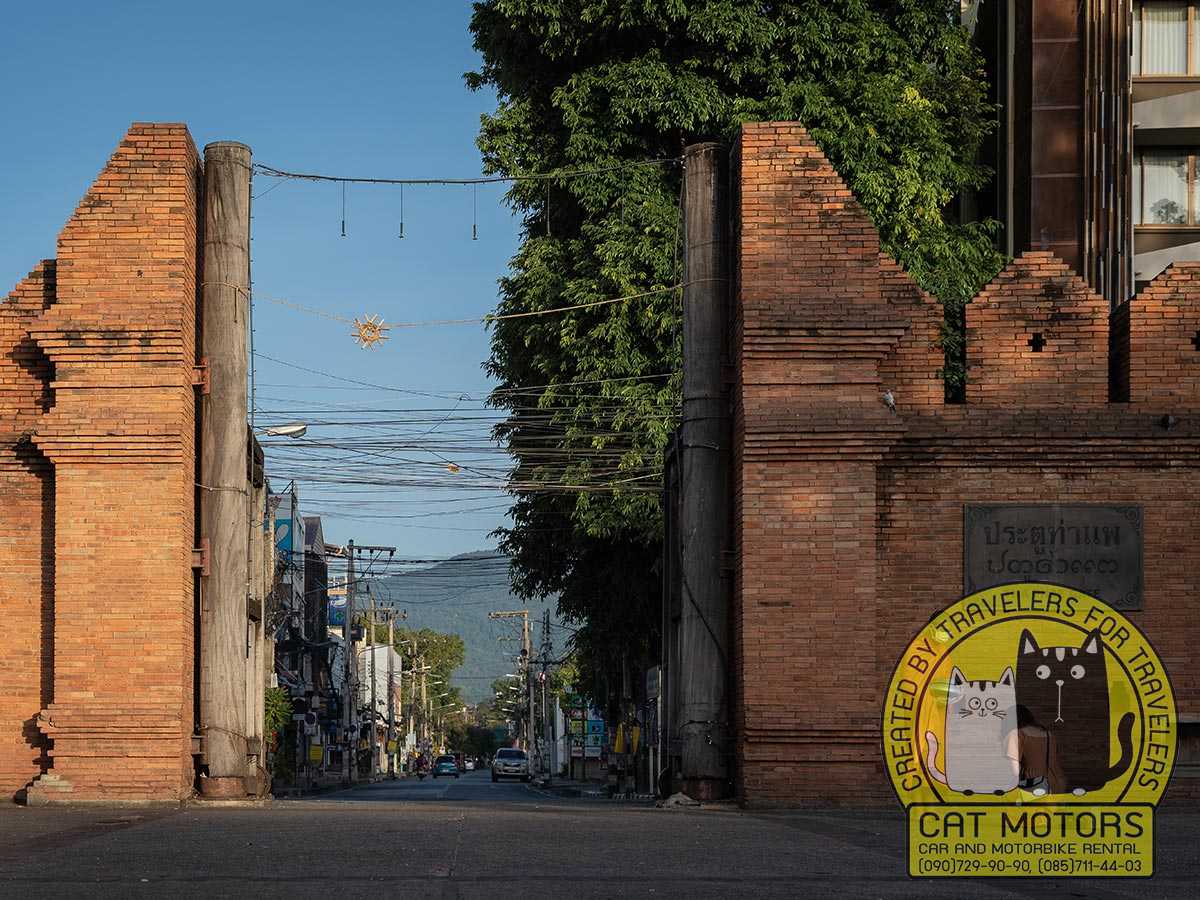
When you visit Chiang Mai, you should visit this historical site and enjoy its surroundings. While the gate only warrants a few minutes, much is happening in the area. Use Tha Phae Gate as a base from which to explore the old city, and be sure to visit it for nighttime entertainment – especially on weekends.
FAQ
Tha Phae Gate is not just an entry point, it’s a symbol of the city’s rich history. Historically, it was one of the four original city gates through which traders brought their wares into Chiang Mai. Its name, “Tha Phae,” translates to “raft landing,” indicating the gate’s role as a customs point where rafts loaded with goods from the Ping River were unloaded.
Tha Phae Gate was originally built around 1296 when King Mangrai founded Chiang Mai. However, the present-day gate is a reconstruction, as the original was eroded over the centuries.
From Chiang Mai International Airport, the easiest way to reach Tha Phae Gate is by taxi or tuk-tuk. It’s a short ride of about 6 kilometers, which usually takes around 15-20 minutes depending on traffic.
Thai people highly respect their historical sites. Therefore, it’s essential to dress modestly and refrain from any disrespectful acts like climbing on the walls. It’s also common to see people releasing birds and fish at the gate for good luck – a fascinating tradition you might want to partake in.
Accommodations around Tha Phae Gate are varied. De Naga Hotel offers a boutique experience with a Northern Thai aesthetic. Thapae Loft provides chic modern design, and Shangri-La Hotel brings world-class luxury. For budget travelers, hostels like Thapae Wow and Sleep Guesthouse offer excellent value.
Tha Phae Gate is a central venue for many of Chiang Mai’s most significant festivals. During Songkran, the Thai New Year, the area around the gate is filled with locals and tourists engaging in playful water fights. During the Yi Peng lantern festival, the sky above Tha Phae Gate fills with thousands of glowing lanterns.
Yes, there are numerous guided tours, both group and private. These tours often encompass other historical and cultural sites within the old city. A knowledgeable guide can provide valuable insights into the history and significance of Tha Phae Gate and the city’s other landmarks.
Nearby attractions include the Sunday Walking Street Market, a lively night market stretching several blocks with food, handicrafts, and live music. Wat Phra Singh and Wat Chedi Luang, two of the most important temples in Chiang Mai, are also within a short distance.
Tha Phae Gate, as a historical monument, doesn’t require a huge amount of time to visit. However, I’d recommend setting aside at least an hour to fully absorb its historical significance, take photos, and perhaps partake in bird or fish release if you wish. Additionally, the surrounding area has lots of shops and restaurants that you might want to explore.
One lesser-known fact about Tha Phae Gate is its historical role in class segregation. The gate was once utilized to separate commoners from the nobility and traders. Common people were not permitted to use the gate; they had to use smaller gates elsewhere in the city walls. It’s a testament to how society and Chiang Mai have evolved over the centuries.
Experience the stunning beauty and vibrant culture of Northern Thailand with our comprehensive travel guides. They highlight the best routes and must-see attractions. Start your journey by exploring our scooter hire in Chiang Mai homepage for the best rental options. Don’t forget to review our terms and conditions for a hassle-free rental experience. These resources will help you prepare for an unforgettable adventure through Northern Thailand’s diverse landscapes.
For further details, check our travel tips section for advice on riding safely, engaging with locals, and discovering hidden gems. This practical information will enhance your travel experience and ensure you have a memorable journey.
If you encounter any inaccuracies in the text or have valuable information to share with our readers, please feel free to contact us.
- Author: Krit Sorenser
- Updated: 04/09/2025
- No Comments




